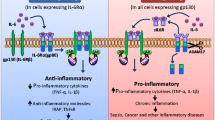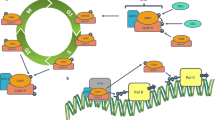Abstract
We have been investigating differential gene expression associated with apoptosis in AK-5 cells (a spontaneously regressing rat histiocytoma) and have observed catalytic subunits beta 7 and alpha 5 of the 26S proteasome and ubiquitin to be upregulated during apoptosis induced by a variety of agents. The observed elevation in gene expression was parallel to a comparable increase in the cytosolic protein expression of the proteasome and ubiquitin and a markedly amplified increase in the proteasome activity. Inhibition of the increase in gene expression resulted in the inhibition of the rise in the proteasome activity subsequently leading to an inhibition of apoptosis. Similarly, pretreatment with proteasome inhibitors, MG132 and lactacystin, resulted in a significant inhibition of apoptosis pointing to the requirement of a highly active protein degradation machinery during apoptosis. The apoptosis inhibitory effect of the proteasome inhibitors involved an inhibition of the activation of various initiator and effector caspases but was independent of any changes in the mitochondrial membrane depolarization and cytochrome c release associated with apoptosis. Inhibition of proteasome activity or its upstream PI3 kinase activity inhibited NFκB translocation thereby suppressing apoptosis, which highlights the requirement of NFκB activation for completion of apoptosis in AK-5 cells. Hence, the apoptosis associated induction of the Ub-proteasome pathway components and the proteasome activity suggests that the proteasome, in its capacity as an efficient protein degradation complex, plays an important role in the successful execution of apoptosis.
Similar content being viewed by others
Abbreviations
- TBST:
-
tris borate sodium tween
- SF:
-
serum factor
- Dex:
-
dexamethasone
- DD-PCR:
-
differential display PCR
- Act D:
-
actinomycin D
- DEVD-AMC:
-
Asp-Glu-Val-Asp-7-Amino-4-methylcoumarin
- YVAD-AMC:
-
Tyr-Val-Ala-Asp-AMC
- Suc-LLVY-AMC:
-
Succinate-Leu-Leu-Val-Tyr-AMC
References
Nunez G, Benedict MA, Hu Y, Inohara N. Caspases: The proteases of the apoptotic pathway. Oncogene 1998; 17: 3237–3245.
Wojcik C. Proteasomes in apoptosis: villains or guardians? Cell Mol Life Sci 1999; 56: 908–917.
Groll M, Ditzel L, Lowe J, et al. Structure of 20S proteasome from yeast at 2.4A resolution. Nature 1997; 386: 463–471.
Demartino GN, Proske RJ, Moomaw CR, et al. Identification, purification and characterization of a PA700-dependent activator of the proteasome. J Biol Chem 1998; 94: 615–623.
Yang Y, Fang S, Jensen JP, Weismann AM, Ashwell JD. Ubiquitin protein ligase activity of IAP's and their degradation in proteasomes in response to apoptotic stimuli. Science 2000; 288: 874–877.
Xiao D, Johnson CS, Trump DL, Singh SV. Proteasome mediated degradation of cell division cycle 25C and cyclin dependent kinase in phenethyl isothiocyanate induced G2-M phase cell cycle arrest in PC-3 human prostrate cancer cells. Mol Cancer Ther 2004; 3: 567–575.
Low P, Bussel K, Dawson SP, Billett MA, Mayer RJ, Reynolds SE. Expression of a 26S proteasome ATPase subunit, MS73, in muscles that undergo developmentally programmed cell death and its control by ecdysteroid harmones in the insect Manduca Sexta. FEBS Lett 1997; 400: 345–349.
Schwartz LM, Myer A, Kosz L, Engelstein M, Maier C. Activation of polyubiquitin gene expression during developmentally programmed cell death. Neuron 1990; 5: 411–419.
Dongquing C, Lee KKH, Li M, Tang MK, Chan KM. Ubiquitin expression is upregulated in human and rat skeletal muscles during aging. Arch Biochem Biophys 2004; 425: 42–50.
Dallaporta B, Pablo M, Maisse C, et al. Proteasome activation as a critical event of thymocyte apoptosis. Cell Death Differ 2000; 7: 368–373.
Beyett J, Mason GG, Murray RZ, Cohen GM, Rivett AJ. Proteasome activities decrease during dexamethasone-induced apoptosis of thymocytes. Biochem J 1998; 332: 315–320.
Almond JB, Snowden RT, Hunter A, Dinsdale D, Cain K, Cohen GM. Proteasome inhibitor induced apoptosis of B-chronic lymphocytic leukemia cells involves cytochrome C release and caspase activation, accompanied by formation of an approximately 700 kDa Apaf-1 containing apoptosome complex. Leukemia 2001; 15: 1388–1397.
Hideshima T, Richardson P, Chauhan D, et al. The proteasome inhibitor PS-341 inhibits growth, induces apoptosis, and overcomes drug resistance in human multiple myeloma cells. Cancer Res 2001; 61: 3071–3076.
Sunwoo JB, Chen Z, Dong G, et al. Novel proteasome inhibitor PS341 inhibits activation of nuclear factor kappa B, cell survival, tumor growth and angiogenesis in squamous cell carcinoma. Clin. Cancer Res 2001; 7: 1419–1428.
Stoklosa T, Golab J, Wojcik C, et al. Increased local vascular endothelial growth factor expression associated with antitumor activity of proteasome inhibitor. Apoptosis 2004; 9: 193–204.
Tabata M, Tabata R, Grabowski DR, Bukowski RM, Ganapathi MK, Ganapathi R. Roles of NFκB and 26S proteasome in apoptotic cell death induced by topoisomerase I and I poisons in human non-small cell lung carcinoma. J Biol Chem 2001; 276: 8029–8036.
Derouet M, Thomas L, Cross A, Moots RJ, Edwards SW. Granulocyte macrophage colony stimulating factor signaling and proteasome inhibition delay neutrophil apoptosis by increasing the stability of Mcl-1. J Biol Chem 2004; 279: 26915–26921.
Lin KI, Baraban JM, Ratan RR. Inhibition versus induction of apoptosis by proteasome inhibitor depends on concentration. Cell Death Differ 1998; 5: 577–583.
Fujioka S, Scmidt C, Sclabas GM, et al. Stabilization of p53 is a novel mechanism for proapoptotic function of NFκB. J Biol Chem 2004; 279: 27549–27559.
Bannerman DD, Tupper JC, Ricketts WA, Benett CF, Winn RK, Harlan JM. A constitutive cytoprotective pathway protects endothelial cells from lipopolysaccharide-induced apoptosis. J Biol Chem 2001; 276: 14924–14932.
Anjum R, Joshi P, Khar A. Induction of apoptosis in AK-5 tumor cells by a serum factor from tumor rejecting animals: cytochrome C release independent of Bcl-2 and caspases. Cell Death Differ 2001; 8: 1038–1046.
Khar A, Ali AM. Adaptation of rat histiocytoma cells AK-5 to grow in culture. In vitro Cell Dev. Biol 1990; 26: 1024–1025.
Liang P, Zhu W, Zhang X, et al. Differential Display using one base anchored oligodT primers. Nucleic Acid Res 1994; 22: 5763–5764.
Singh S, Khar A. Differential gene expression during apoptosis induced by a serum factor: role of mitochondrial F0-F1 ATP synthase complex. Apoptosis 2005; 10: (in press)
Chaturvedi MM, Mukhopadhyay A, Aggarwal BB, Packer L, Sies H (eds). Assay for redox-sensitive transcription factor. Methods Enzymol 2002; 319: pp 585–602.
Gurtu V, Kain SR, Zhang G. Fluorometric and colorimetric detection of caspase activity associated with apoptosis. Annal Biochem 1997; 251: 98–102.
Dawson SP, Arnold JE, Mayer NJ, et al. Developmental changes of the 26S proteasome in abdominal intersegmental muscles of Manduco Sexta during programmed cell death. J Biol Chem 1995; 270: 1850–1858.
Mitsiades N, Mitsiades CS, Poulaki V, et al. Molecular sequelae of proteasome inhibition in human multiple myeloma cells. Proc Natl Acad Sci USA. 2002; 99: 14374–14379.
Xu B, Monsarrat B, Gairin JE, Girbal-Neuhauser E. Effect of ajoene, a natural antitumor small molecule, on human 20S proteasome activity in vitro and in human leukemic HL60 cells. Fundamental & Clinical Pharmacology 2004; 18: 171–180.
Engidawork E, Juranville JF, Fountoulakis M, Dierssen M, Lubec G. Selective upregulation of the ubiquitin proteasome proteolytic pathway proteins, proteasome zeta chain and isopeptidase T in fetal down syndrome. J Neural Transm Suppl 2001; 61: 117–130.
Shah SA, Potter MW, McDade TP, et al. 26 S proteasome inhibition induced apoptosis limits growth of human pancreatic cancer. J Cell Biochem 2001; 82: 110–122.
Henfling ME, Ramaekers FC, Schutte B. Proteasome act in the pre-mitochondrial signal transduction route towards roscoviline-induced apoptosis. Int J Oncol 2004; 25: 1437–1446.
Stefanelli C, Bonavita F, Stanic I, et al. Inhibition of etoposide induced apoptosis with peptide aldehyde inhibitors of proteasome. Biochem J 1998; 332: 661–665.
Hirsch T, Dallaporta B, Zamzami N, et al. Proteasome activation occurs at an early premitochondrial step of thymocyte apoptosis. J Immunol 1998; 161: 35–40.
Wang GP, Khatoon S, Iqbal K, Grundek II. Brain ubiquitin is markedly elevated in Alzheimer disease. Brain Res 1991; 566: 146–151.
Dawson S, Hastings R, Takayanagi K, et al. The 26S proteasome-regulation and substrate recognition. Mol Biol Reports 1997; 24: 39–44.
Fujihara S, Ward C, Dransfield I, et al. Inhibition of nuclear factor-κB activation un-marks the ability of TNF-α to induce human eosinophil apoptosis. Eur J Immunol 2002; 32: 457–466.
Yabe T, Wilson D, Schwartz JP. NF(kappa)B activation is required for the neuroprotective effects of pigment epithelium-derived factor (PEDF) an cerebellar granule neurons. J Biol Chem 2001; 276: 43313–43319.
Tarabin V, Schwaninger M. The role of NF-kappa B in 6-hydroxydopamine and TNF alpha-induced apoptosis of PC 12 cells. Naunyn Schmiedebergs Arch Pharmacol 2004; 369: 563–569.
Campbell KJ, Rocha S, Perkins ND. Active repression of antiapoptotic gene expression by Rel A (P65) NFκB. Mol Cell 2004; 13: 853–865.
Zhuang WJ, Fong CC, Cao J, et al. Involvement of NF-kappa B and c-myc signaling pathways in the apoptosis of HL-60 cells induced by alkaloids of Tripterigium hypoglaucum (Levl.) Hutch Phytomedicine 2004; 11: 295–302.
Thyss R, Virolle V, Imbert V, Peyron JF, Aberdam D, Virolle T. NF-kappa B/Egr-1/Gadd45 are sequentially activated upon UVB irradiation to mediate epidermal cell death. EMBO J 2005; 24: 128–137.
Do Y, McKallip RJ, Nagarkatti M, Nagarkatti PS. Activation through cannabinoid receptors 1 and 2 on dendritic cells triggers NF kappa B dependent apoptosis: novel role for endogenous and exogenous cannabinoids in immunoregulation. J Immunol 2004; 173: 2373–2382
Poppelmann B, Klimmek K, Strozyk E, Voss R, Schwartz T, Kulms D. NF(kappa) B-dependent down-regulation of tumor necrosis effector receptor associated proteins contributes to interleukin-1-mediated enhancement of ultraviolet B-induced apoptosis. J Biol Chem 2005; 280: 15635–15643.
Beraud C, Henzel WJ, Baeuere PA. Involvement of regulatory and catalytic subunits of phosphoinositide 3-kinase in NFκB activation. Proc Natl Acad Sci USA 1994; 96: 429–434.
Author information
Authors and Affiliations
Corresponding author
Rights and permissions
About this article
Cite this article
Singh, S., Khar, A. Activation of NFκB and Ub-proteasome pathway during apoptosis induced by a serum factor is mediated through the upregulation of the 26S proteasome subunits. Apoptosis 11, 845–859 (2006). https://doi.org/10.1007/s10495-006-5878-4
Published:
Issue Date:
DOI: https://doi.org/10.1007/s10495-006-5878-4




